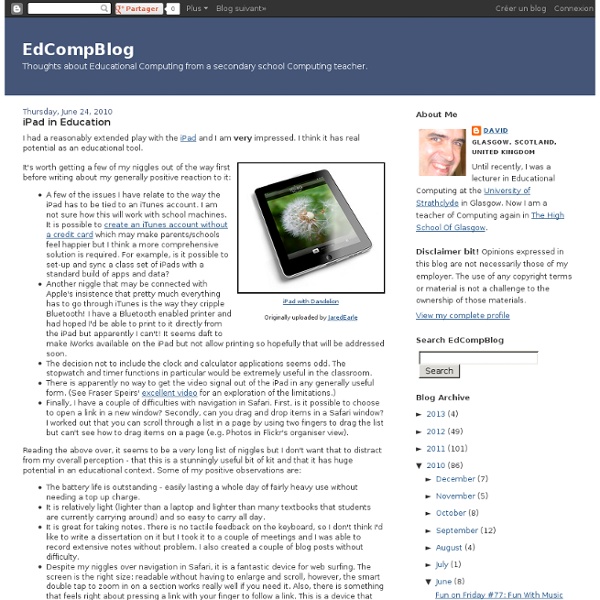



iPad Apps for Education Add As the first real contender in the category of streamlined computing tablets, the iPad has captured its share of hype. The iPad’s potential remains undeniable, particularly in education. Education is discovery, education is interaction, and education is exploration. These are all activities facilitated by the iPad. I believe that the ultimate goal of the iPad (and its future ilk) is to be so intuitive that the user will forget they are interacting with a piece of technology. The iPad (or any technology) will not replace live instruction, as some have suggested, anytime soon. Few barriers stand between my vision for the classroom of tomorrow and the iPad concept as it stands today. For a more concrete sense of what the iPad can do, I’ve made my picks for the best existing iPad apps for education, and provided examples of where I hope developers take their apps in the near future. Top 3 Education Apps of Today 1. 3D Cell Simulation and Stain Tool 2. Star Walk Screenshot 3. 2. iSalieri 3.
Teachers Love SMART Boards: SMART Board: Tips Here is a article called “Whiteboards for Dummies” written by Calvin Hennick for Scholastic – Administrator. This article discusses how to utilize your SMART Board more effectively by identifying some of the obstacles of using a SMART Board once you get it into your classroom. The stories about using it to hang... read more It’s finally here! I’ve been extremely excited for some time now about introducing a new resource for teachers called The Notebook Gallery. In 2007, I created a WallWisher Wall called Why do Teachers Love SMART Boards and asked teachers to write a short comment on why they loved their SMART Board. Here's a short video tutorial on how to extend a Notebook theme farther down on the page. I'm excited to announce a new podcast called Get SMART with SMART Boards. Are you a SMART Board user? This is the solution to Challenge #12 called "Watch This." I hope you'll be as amazed as I was with the submissions for this week's challenge – Random Number.
Seven Videos All Educators Should Watch - StumbleUpon Summer is a time when many of us are thinking about and planning professional development workshops for our schools and for other schools. I've always found that a short 3-5 minute video can be a good introduction to a PD sessions and or make for a nice thought-provoking break during a PD session. Here are seven videos that I think serve those purposes well. The "classic" of course is the various incarnations of Karl Fisch's and Scott McLeod's Did You Know? Educational Change Challenge is a video that I came across just last week on the first day of ISTE 2010. Here's another "classic" in the field. Social Media Revolution is a must-watch for all of those who think social media is nothing more than a time-sink. And when you're wondering what teachers make, Taylor Mali has some answers for you. Here's a good one produced by Kevin Honeycutt about the need for teachers to continuously improve, adapt, and adopt new strategies for reaching their students.
Teacher Resources and Classroom Games :: Teach This Texting in the Classroom: Not Just a Distraction The Pew Research Center released new data this week on Americans' text-messaging habits. According to Pew, 83 percent of American adults now own cell phones and almost three-quarters (73 percent) send and receive text messages. The research only looks at adults' usage of text-messaging, but it does find that younger adults are much more active texters than older age groups. Cellphone owners between the ages of 18 and 24 exchange an average of 109.5 messages a day -- that's more than 3200 messages per month. The Pew study doesn't look at the texting habits of those under age 18, but a study released last year by Nielsen found that those cellphone users in the 13 to 17 age range were the most avid texters among any age group. Certainly that age group -- in fact, all those under 18 -- are increasingly likely to be cellphone owners. With the ubiquity of cellphones, many schools are facing questions about what to do when students bring cellphones to school.
iPads Make Better Readers, Writers Literacy Skills iPads Make Better Readers, Writers In a research paper titled “Unlocking Literacy with iPad,” Ohio English teacher James Harmon found that state-compiled statistics indicate that those students with iPad access in the year leading up to the Ohio Graduation Test had a 6-percent greater chance of passing the test’s reading portion than those without, and an 8-percent greater chance of passing the writing portion. By Margo Pierce09/06/11 Once upon a time teachers stood in front of a blackboard writing letters of the alphabet with chalk and drilling students to develop literacy skills. But now that children are growing up with laptops, streaming video, and even iPads, what’s a teacher to do? During the 2010-2011 school year Harmon conducted a “teacher-research” study to measure the effect Apple’s iPad had on the language test scores of his students taking the annual Ohio Graduation Test. This convinced Harmon of the appropriateness of the iPad as a teaching tool.